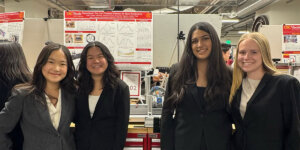
Image provided by Sze-Chuan Suen
USC Viterbi’s Sze-chuan Suen, assistant professor in the Daniel J. Epstein Department of Industrial and Systems Engineering, combats contagion from her laptop.
With a background in biology and economics, combined with a Ph.D. in Management Science and Engineering from Stanford, Suen applies her skills in computer simulation and modeling to influence public health policy and improve medical decision-making.
At USC, Suen aims to leverage her background in modeling tuberculosis (TB) to improve L.A. County Department of Public Health’s tuberculosis treatment protocols. She believes that with her prior expertise she can help model disease rates and the cost impact of new TB treatment programs in the LA area, helping to understand which policies would be most effective. Suen brings her experience modeling TB in India to the table and is excited to work cross-disciplinarily with the USC Schaeffer Center, which focuses on the intersection of economic research and health policy.
“I really like understanding human behavior and how people operate when they make decisions,” she said, “there are a lot of situations in healthcare where people knows they should make certain decisions and but they don’t.”
Prior to becoming a Trojan, Suen took her fight against disease to India, battling multi-drug resistant tuberculosis (MDR-TB). In India, TB rates are near epidemic, with the World Health Organization reporting close to two million confirmed cases of tuberculosis annually; 480,000 of those infected die.
Although cases of ordinary TB are on the decline, instances of drug-resistant TB are increasing. Sixteen percent of previously treated TB cases in India are of the drug-resistant variety. MDR-TB can develop in ordinary TB patients who fail to follow through with their drug treatment course, or through direct transmission of existing cases of MDR-TB. The upsurge of MDR-TB cases has doctors wondering how best to stop the spread of the new and deadly disease.
As a developing nation, where cost is often the largest obstacle to effective treatment, India faces tough decisions in determining how to allocate scarce resources to treat and halt the spread of MDR-TB. Should money go into new technologies, government healthcare programs, or both?
In this situation, where spending money on the wrong program can mean lives lost, every dollar counts. This is where Suen’s research plays a valuable role as it helps physicians and leaders to compare treatment options and make informed decisions for the best outcomes.
In one project, Suen and her team designed a computer simulation model to compare two government strategies for intervention: improving non-drug resistant TB treatment versus improving screening methods to catch more cases of MDR-TB. To examine how each strategy affected MDR-TB transmission, the model considered a variety of factors, including age, sex, and patient behavior.
To carefully construct an accurate model, Suen worked closely with TB physicians, gathering information on how the disease is transmitted as well as how patients respond to treatment. Her findings determined that improving diagnostics could reduce instances of MDR-TB by 39 percent. In addition, even though improving diagnostics nationwide could be much more expensive than other interventions, there is evidence that it would be cost-effective for the Indian TB epidemic, she said.
When asked what motivates her, Suen said: “It’s amazing how mathematical tools can give us insight into really difficult, complex problems, even ones that rely on factors like human behavior and health.”
Suen said she’s thrilled to join the USC Viterbi faculty.
“Everybody is so welcoming,” she said. “It’s very exciting here. The CAIS (Center for AI and Social Good) in particular creates some groundbreaking work, and it’s exciting to work in a place where these projects are in the foreground.”
Next semester, Suen will teach a hands-on course: ISE 599 – Modeling for Health Policy and Medical Decision.
“Students will see a survey of the various techniques people use in operations research to model health policy problems,” she said.
“For students interested in applying computer-modeling techniques to solve real world problems, this is the place to be.”
Published on April 13th, 2017
Last updated on April 17th, 2017












